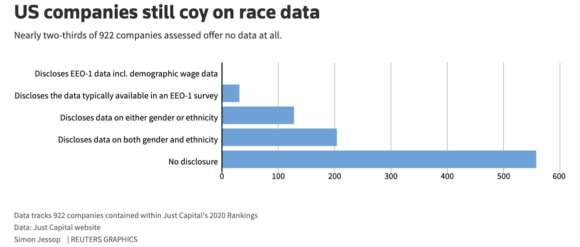American companies are coming under increasing pressure from investors to publicly disclose information about diversity among employees in the wake of nationwide protests against racial discrimination.
Many executives have pledged to champion equality in response to the Black Lives Matter demonstrations across the United States and beyond.
The goal of global investors increasingly focused on social and governance issues is to gain a common metric on racial diversity to compare companies and hold them to account on their pledges, building on a drive to improve gender equality.
The good news, they say, is that U.S. firms with more than 100 employees already gather such data for the federal government annually via a form known as the EEO-1, along with gender information.
However, the data is confidential and companies are not required to publicly release it, with some arguing it does not accurately capture the structure of their businesses.

Only 32 companies in the Russell 1000 make the information public, according to researcher Just Capital, either via the form itself or through detailed summaries.
“The EEO-1 is not the holy grail, but it’s an excellent starting point,” said John Streur, chief executive of Calvert Research and Management, an investment firm pressing executives to publicly disclose the data.
Once companies began releasing information, it would create competition to improve diversity, he added.
This was echoed by Mirza Baig, Global Head of Governance at London-based Aviva Investors, part of insurer Aviva.
“We think it’s inevitable that those data points will be disclosed and we think companies should get ahead of it.”
UNDERREPRESENTED
Companies that file the EEO-1 form, to the U.S. Equal Employment Opportunity Commission (EEOC), record the number of workers they have of each race and gender across 10 job categories, including senior officials, sales workers and technicians. The latest filings are for 2018, as the 2019 deadline was deferred to 2021 due to the COVID-19 pandemic.
The data reveals some very unequal pictures.
For instance, of 290 executives and top leaders at Uber Technologies Inc, one of the companies to publicly release the information, seven were Black and nine were Hispanic or Latino in the payroll period covering the last two weeks of 2018.
Both figures represented only around a 3% share of top positions, well below the two groups’ proportion of the U.S. population, of about 13% and 19% respectively.
At Bank of America Corp., in another example, Black people held 5% of 4,197 top-level roles as of last year, and Hispanic or Latino people held another 4%.
The figures are broadly in line with aggregated EEOC data showing that of the roughly 900,000 people holding those top jobs across the country, about 3% were Black and 4% were Hispanic in 2018.
Companies that disclose the data, like Uber and Bank of America, show a more serious effort to improve minority representation, said Donald Tomaskovic-Devey, a University of Massachusetts professor who studies workplace diversity.
“Transparency is a prerequisite for both goal-setting and accountability,” he added.
An Uber spokeswoman said the company “is committed to investing in long-term strategies to create a sustainable pipeline of talent from historically underrepresented communities.”
Bank of America says on its website it is “focused on attracting, retaining and developing diverse talent.”
‘WALK THE WALK’
There has been a marked shift in attitudes since the protests sparked by the death of George Floyd in police custody in Minneapolis on May 25.
Companies have collectively pledged hundreds of millions of dollars and to remake their own workforce profiles.
However firms voicing support for racial equality should back up their talk by releasing their EEO-1 data, New York City Comptroller Scott Stringer says in letters being sent to 67 companies in the S&P 100.
“We’re asking companies that condemned racism to walk the walk,” Stringer, who oversees some $206 billion in retirement assets, told Reuters.
Activist investors say efforts to make diversity data public are gathering momentum, partly since this can be easier than reforms like adding social metrics to CEO pay programs or naming new board members.
For instance, at cybersecurity company Fortinet Inc’s annual meeting on June 19 – the “Juneteenth” U.S. holiday marking the end of slavery in 1865 – 70% of shares voted backed a resolution to report on its workforce diversity.
Kristin Hull, CEO of resolution sponsor Nia Impact Capital, said the vote tally – a record high among similar resolutions at U.S. companies according to the Sustainable Investments Institute – reflected the current discussion about race in corporate America.
A Fortinet spokesman said it planned to release its EEO-1 data.
MATCHING THE WORKFORCE
However to date, most companies have shied away from public disclosure of EEO-1 data. Executives say privately they worry about legal liability, bad publicity and attracting rivals’ recruiters if they employ many minorities.
Some argue the form’s categories such as “craft workers” or “laborers” aren’t relevant to their businesses.
Even some of the activists do not give out their data. “We have not historically published the EEO-1 forms, but we are reviewing that approach,” said Robyn Tice, spokeswoman for Calvert parent Eaton Vance Corp.
Some companies do disclose data, but on their own terms.
Just Capital counted 204 companies that disclosed some information on the gender and ethnicity of their employees as of August 2019, often in non-standard ways.
In a report on its website, for example, Starbucks Inc states that 17.5% of its executives ranked at senior vice president or higher are “People of Color.”
A Starbucks spokeswoman said it was reviewing whether to release its EEO-1 data publicly.
Others disclose little data currently, like Snapchat parent Snap Inc.
Snap CEO Evan Spiegel said in a CNBC interview on June 11 that, while it was working on providing more details, it was worried that disclosures “have actually normalized the current composition of the tech workforce,” which has few minorities.
A Snap spokeswoman said the company planned to disclose a breakdown of its employees by race and gender as the EEO-1 form outlined, but would likely use different job categories that better matched its workforce. It also plans to show additional data such as hiring rates, she added.
For an interactive version of the graphic, click here https://tmsnrt.rs/2Nq8D62.
HOW MUCH IS ENOUGH?
Calvert’s Streur mentioned Home Depot Inc as an example of a company that could expect more pressure to release its full EEO-1 data.
Nearly every year since 2005, shareholder activists have put a resolution on the idea to a vote at the retailer’s annual meeting – an uncommonly long run.
The company has opposed the resolutions. In its notice for this year’s meeting, held on May 21, it noted it began releasing certain diversity data annually in 2018.
In 2018, 48% of shares cast backed a resolution calling for the EEO-1-level disclosure. A similar resolution got 36% support at this year’s meeting, held four days before Floyd’s death.
A Home Depot spokeswoman said it was “committed to diversity and equal opportunity.” She cited a company diversity report, which states minorities made up 44% of its workforce in 2018.
American Century’s Sustainable Equity Fund was one backer of the resolution this year, according to Guillaume Mascotto, vice president for the fund manager.
He said the national conversation about race would make more shareholders likely to back calls for disclosure in the future.
“More and more investors, especially those that have a long-term horizon are going to want to see how companies are approaching this.”
(Reporting by Ross Kerber in Boston and Simon Jessop in London; Editing by Pravin Char)
Was this article valuable?
Here are more articles you may enjoy.



 Nearly Half of 100 Largest P/C Insurers Destroy Value: ACORD
Nearly Half of 100 Largest P/C Insurers Destroy Value: ACORD  Experian: AI Agents Could Overtake Human Error as Major Cause of Data Breaches
Experian: AI Agents Could Overtake Human Error as Major Cause of Data Breaches  CEOs on Guard as Trump Rattles Companies With Series of Edicts
CEOs on Guard as Trump Rattles Companies With Series of Edicts  Good Times for US P/C Insurers May Not Last; Auto Challenges Ahead
Good Times for US P/C Insurers May Not Last; Auto Challenges Ahead 

